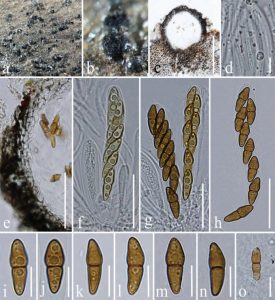Lentithecium cangshanense Z.L. Luo, X.J. Su & K.D. Hyde, sp. nov., Index Fungorum number: IF 552050
Etymology: With reference to the collecting location, Cangshan Mountain.
Holotype: HKAS 84021.
Saprobic on decaying wood submerged in freshwater. Sexual morph: Ascomata 210-310 μm high, 220-320 μm in diam, scattered, black, immersed to partially erumpent, globose to subglobose, glabrous, with papilla visible as raised, dark spots on host surface, ostiole central. Peridium 20-29 μm wide, of equal thickness, composed of several layers of pseudoparenchymatous cells, arranged in a textura angularis, pigmented at the outer part. Hamathecium comprising numerous, 2.5-3.5 μm wide, septate pseudoparaphyses, embedded in a mucilaginous matrix, rarely anastomosing between and above the asci. Asci 65–78× 11–13 μm (x̅ = 71 × 12μm, n = 20), cylindric-clavate, pedicellate, apically rounded, with an ocular chamber. Ascospores 16.5–17.5 × 6–7 μm (x̅ = 17 × 6.5 μm, n = 20), bi-seriate, hyaline to subhyaline when young and pale brown to brown when mature, broadly fusiform, inequilateral in side view,1-septate, slightly constricted at the septum, upper cell wider, smooth-walled, with four refractive globules. Asexual morph: Undetermined.
Material examined: CHINA, Yunnan Province (N 25°50’52.39”, E 100°05’59.87”), saprobic on decaying wood submerged in a stream, July 2013, Z.L. Luo, S-143 (HKAS 84021, holotype), ex-type culture, DLUCC 0143 = KUMCC; ibid. (DLU14–143, isotype).
Notes: Lentithecium cangshanense is typical of Lentithecium being characterized by scattered, semi-immersed to superficial, ascomata, septate pseudoparaphyses, bitunicate, pedicellate asci, bi-seriate, pale brown to brown ascospores which are slightly constricted at the septum. Lentithecium cangshanense resembles L. aquaticum in having scattered ascomata, a peridium of textura prismatica and broadly fusiform, ascospores which are in equilateral in side view, and have four refractive globules and slightly constricted at the septum. However, L. cangshanense differs from L. aquaticum in having a thicker, pale black to hyaline peridium, narrower and shorter asci (x̅ = 71.5 × 12 μm, versus 175 × 21 μm) and smaller ascospores (x̅ = 17 × 6.5 μm, versus 28 × 10.5 μm). In addition, the molecular analysis showed that this new fungus is clusters with L. fluviatile with strong support. However, they have different morphological characters, L. cangshanense differs from L. fluviatile in having pale brown to brown, smaller sacospores (16.5–17.5 × 6–7 μm, versus 24–31 × 7–10 μm).
Fig. 2. Lentithecium cangshanense (HKAS 84021, holotype). a, b Ascomata on submerged bamboo. c Section through ascoma. d Pseudoparaphyses. e Section of peridium. f–h Asci. i–n Ascospores. o Germinating ascospore. Scale bars: c = 150 μm, e = 100 μm, f–h = 25 μm, o = 20 μm, d, i–n = 10 μm.

